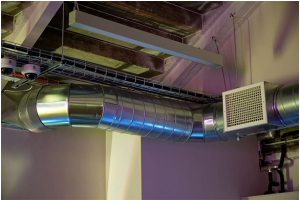Most commercial and many residential air conditioning systems deliver conditioned air through ducts. Their purpose varies – heating, cooling, humidity-control or the provision of clean filtered air – but the basic structure is similar. Many systems serve all of the above functions.

Most modern ducts are cylindrical, because a circular cross-section promotes a steady airflow, reduces energy loss, and mitigates dust accumulation. However, they can be many shapes or can even make use of the spaces between rafters, joists or wall studs.
Air handler units
Many components are centralized in an air handler unit (AHU). Typically, this contains the fan, air filters, and heating and/or cooling coils. Noise baffles, humidity conditioners, and airflow dampers are also often found here.
Depending on the building, the AHU can be located indoors (often in a basement), outdoors, or on the roof. Those packaged for outdoor locations are often referred to as package units (abbreviated PU) or rooftop units (RTU).

Ductwork parts
Ductwork must deliver balanced and safe airflows to every part of the building. This is a challenging science, so the design of HVAC systems is a job for professionals. Environmental, Health & Safety, and F-gas regulations also apply, as do new regulations about energy efficiency.
At the root of a ductwork “traffic system” is the plenum. The plenum ensures that the right amount of air branches off to each part of the building with sufficient force and flow. It also collects return air. Flow rate and direction are regulated at other locations in the building too, using a variety of devices.
Volume control dampers are devices that open or close to increase or decrease the flow. They can work either by throttling flow through the duct or by releasing excess pressure to an external or return vent. Smoke and fire dampers are often installed to seal the ducts completely if smoke is detected.
Dampers can also be used to help separate different zones of a building, prevent backdrafts, or as part of an airflow monitor. You can see a variety of types here: https://www.dustspares.co.uk/ductwork-parts/.
Other airflow controllers include diffusers, registers, and grilles. Branch points and duct bore also affect the airflow and energy efficiency, so fitting appropriate “ells” (turns) “tees”, reducer couplings and takeoffs is important.
Finally, the vents are usually angled, or adjustable, to direct air in the desired directions.



